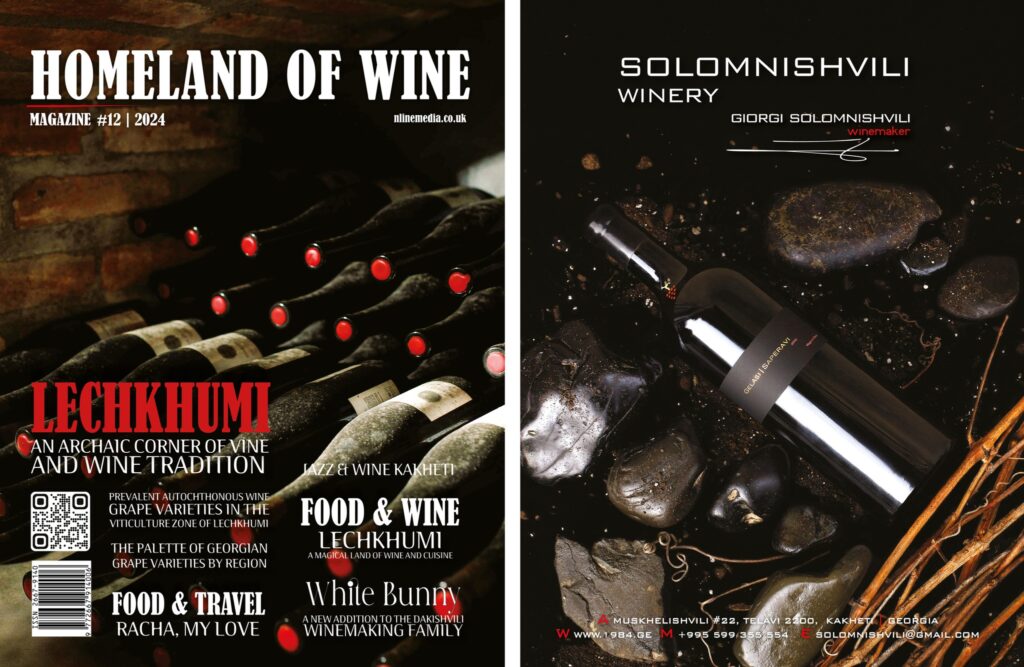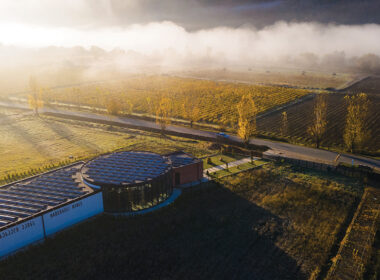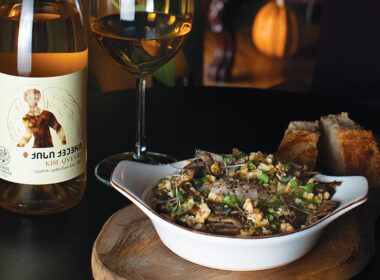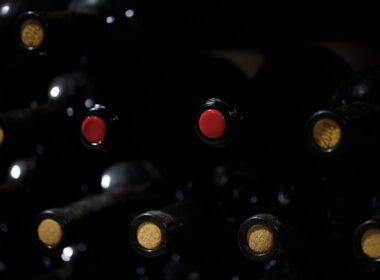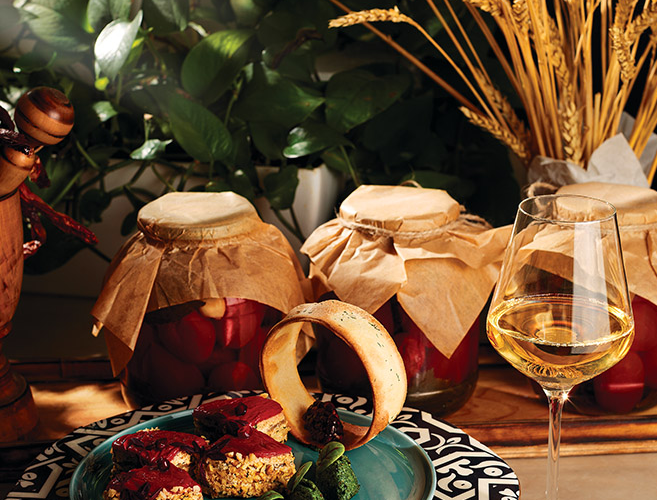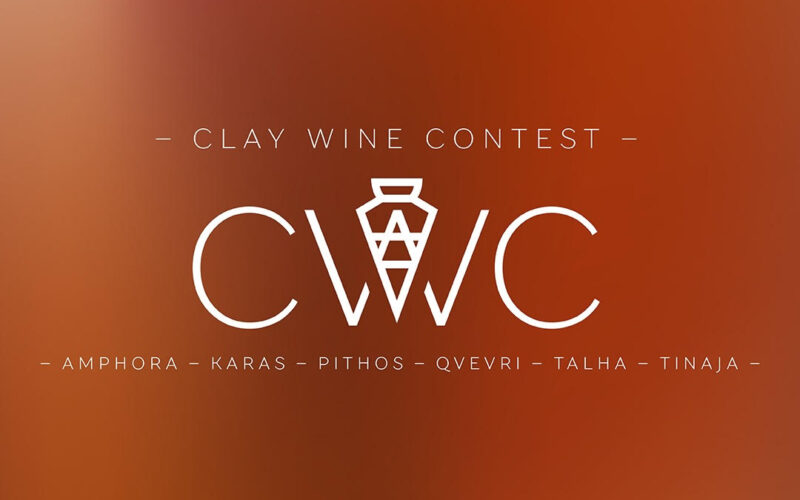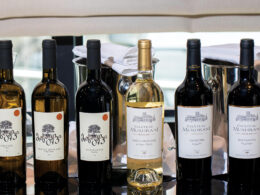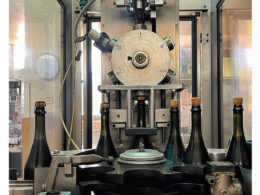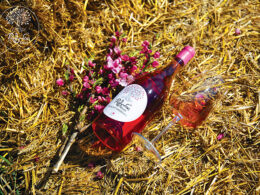| Tazo Tamazashvili |
Lechkhumi is one of Georgia’s winemaking regions that has particularly captured my attention in recent years. I first visited the area six years ago. During the harvest of a local small producer, David Chakvetadze, I explored the vineyards and natural surroundings, including the Khvamli Mountain. My first impression was that Lechkhumi feels like a grand fortress nestled in a heavenly garden, surrounded by towering rocks yet rich with greenery. Why do I bring this up? Because Lechkhumi’s greatest treasures are its unique location, and of course, the people who preserve and carry on the region’s rich winemaking traditions. Yes, Lechkhumi has a rich winemaking tradition. Here, we have the perfect combination of climate and soil, along with noteworthy grape varieties.
Today, Lechkhumi, alongside Racha, is recognized as part of the Racha-Lechkhumi winemaking region, though the two remain distinct. Lechkhumi also borders Svaneti, a region that has always differed from Racha in both culture and traditions. Since wine was never produced in Svaneti, Racha-Lechkhumi has been distinguished from other mountainous winemaking regions.
The vineyards in Lechkhumi boast an excellent location, with most of them nestled in the Rioni and Tskhenistskali river valleys. Tsageri serves as the main regional centre, uniting the winemaking villages. I would also like to highlight Alpana, which is part of both the Khvanchkara and Tsolikouri PDO zones, while being associated with the Tvishi PDO zone as well.
Tvishi is a PDO wine, registered as a white, naturally semi-sweet wine. Other variations, such as dry wine, are not permitted under the regulations. Only the Tsolikouri grape variety is used to produce Tvishi.
In the Tsageri municipality lies the village of Okureshi. It is an absolutely fantastic place, built like a fortress in a landscape surrounded by cliffs and lush greenery, as previously mentioned. The village features stunning slopes that are highly favourable for vineyards due to their excellent drainage capabilities.
Okureshis Usakhelouri is another PDO wine. Traditionally known as a naturally semi-sweet wine from the Soviet era, Usakhelouri now also permits the production of dry and semi-dry wines. It is one of the most expensive grape varieties in Eastern Europe due to its rarity and high quality, which are attributed to the unique soil and climate conditions in Lechkhumi.
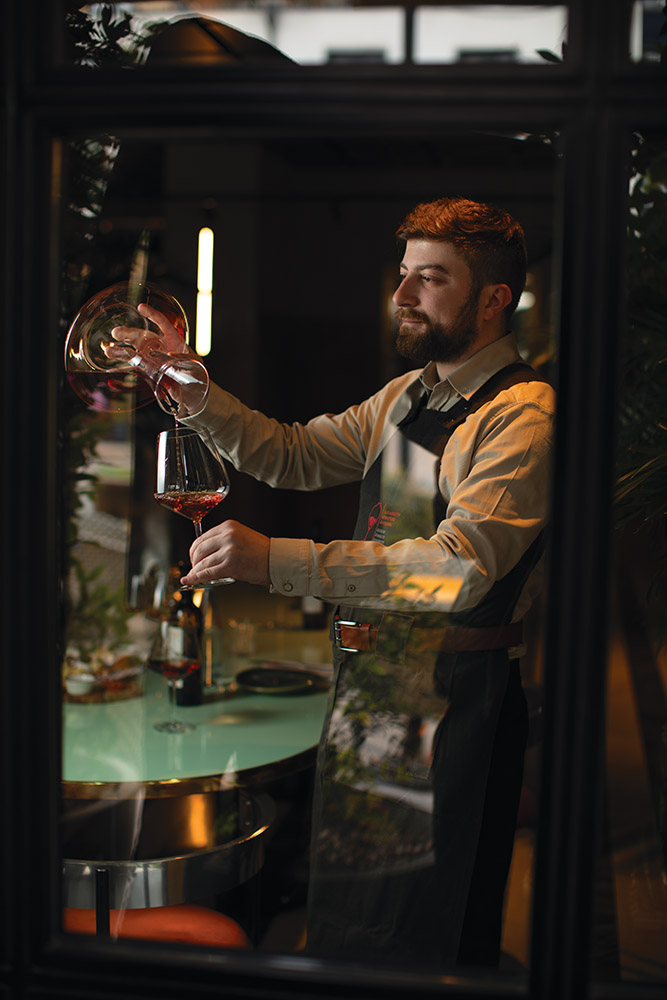
The alternating warm summer days and cool nights enhance the development and complexity of aromas in the grapes. In this regard, Lechkhumi truly stands out for its unique white and red grape varieties.
In Lechkhumi, Tsolikouri has traditionally been crafted as a dry wine, even before the naturally semi-sweet Tvishi was registered as a PDO wine. This tradition continues to this day. Lechkhumi Tsolikouri is distinguished by its vibrant acidity, which allows it to age well in the bottle for many years. Tsolikouri can be favourably compared to the international variety (and one of my favourites) Riesling.
When discussing the prospects for Lechkhumi, it is crucial to emphasise the need for further exploration of its terroirs, updating the vineyards, and accurately aligning the PDOs and wine styles with the region. There are many villages where different terroirs can be found. While it may not be necessary to have numerous PDO zones in small Lechkhumi, it is clear that terroirs should be distinguished by their names. I made a similar point about Guria in the previous issue. Lechkhumi has similar potential; being a small region, it needs to carve out its own specific niche to be properly assessed and appreciated.
Lechkhumi is characterised by its many slopes. While cultivating and managing vineyards in such a landscape is challenging, there are several renowned regions with similar terrain, such as those in Austria and Germany, that have successfully managed it.
I always compare Georgia’s small winemaking regions to well-developed regions around the world that share similarities in grape varieties, landscape, and exposure. For example, Italy has a similar mountainous region called Trentino-Alto Adige. I have often encountered winemakers in Alto Adige who have a centuries-old tradition of producing wine from local unique grape varieties. And Lechkhumi is a similarly small region with its own unique character and excellent grape varieties, including Usakhelouri, which is a defining feature of the area, as well as Tsolikouri and Orbeluri Ojaleshi. (In Lechkhumi, the village of Orbeli could easily become a PDO or terroir.)”
Lechkhumi is surrounded by mountains, which act as a protective barrier, shielding the region from drought and hail (which have recently become more frequent in various parts of Georgia).
In Lechkhumi, one can find small producers and family-owned wineries that make traditional qvibari (syn.: qvevri in Lechkhumi) and churi (syn.: qvevri in Western Georgia) wines. Generally, this region has a stronger emphasis on traditional wine styles compared to classic.
Qvibari is a small wine making vessel that is commonly used in Lechkhumi. Here, the capacity of qvibari and churi is measured in doras (a unit of measurement). A vessel smaller than three doras is called a qvibari, while a larger one is called a churi. It is approximately 80 centimetres in height. Lechkhumi qvibari and Imeretian kotso are names that refer to the same type of vessel. Qvibari is a very convenient and useful container for storing wine, as oxidation is less likely to occur in it. Its small size also means it is less prone to damage compared to larger vessels like churi or qvevri. This type of container is found exclusively in Lechkhumi under this name.
The names for the measurement units also vary across different regions of Georgia; for example, in Lechkhumi, it is called a dora, while in Imereti, it is called a puti.
As for the prospects for PDO wines and the diversification of styles, which is certainly possible in this region: Lechkhumi produces Tvishi, a naturally semi-sweet wine. Sweet wines are generally well-received worldwide, and more sophisticated techniques, such as late harvest, are also popular. Ice wine could also be produced here, provided the grape varieties can withstand winter frost. I believe that Usakhelouri and Tsolikouri would be particularly well-suited for this style.
In this region, various grape varieties are used for winemaking, including Tsulukidze Tetra, Dzelshavi, and Rachuli Mtsvane. Tsolikouri is the primary white grape variety, and, given Tvishi’s protected designation of origin, there is significant demand for it.
As for Okureshis Usakhelouri, as I mentioned earlier, the naturally semi-sweet Usakhelouri was popular during the Soviet era, which has completely diminished and continues to diminish the grape’s true characteristics and significant potential. Wine made from Usakhelouri should be dry. When we discuss Georgian fine wines, we are referring to the dry wine style. Today, in my view, there should be no debate about the merits of dry versus semi-sweet wines in exceptional regions like Lechkhumi.
The development of tourism in such small regions is crucial, as it offers more and more people from various countries the chance to visit this beautiful area and experience its culture, traditions, and cuisine. Wine tourism, in particular, needs to grow, as it fosters the production of more refined wines. This is a place where wine writers, sommeliers, critics, and wine master’s should come as tourists, allowing local wines to transcend a single style or market.
This would provide an excellent opportunity for both established and new winemakers to advance the region, expand vineyard areas, and produce higher quality wine.
Pairing Lechkhumi Dishes and Wines
Signature Lechkhumi dishes have been prepared for us by Temo Gigauri, the brand chef at Wyndham Grand Tbilisi.
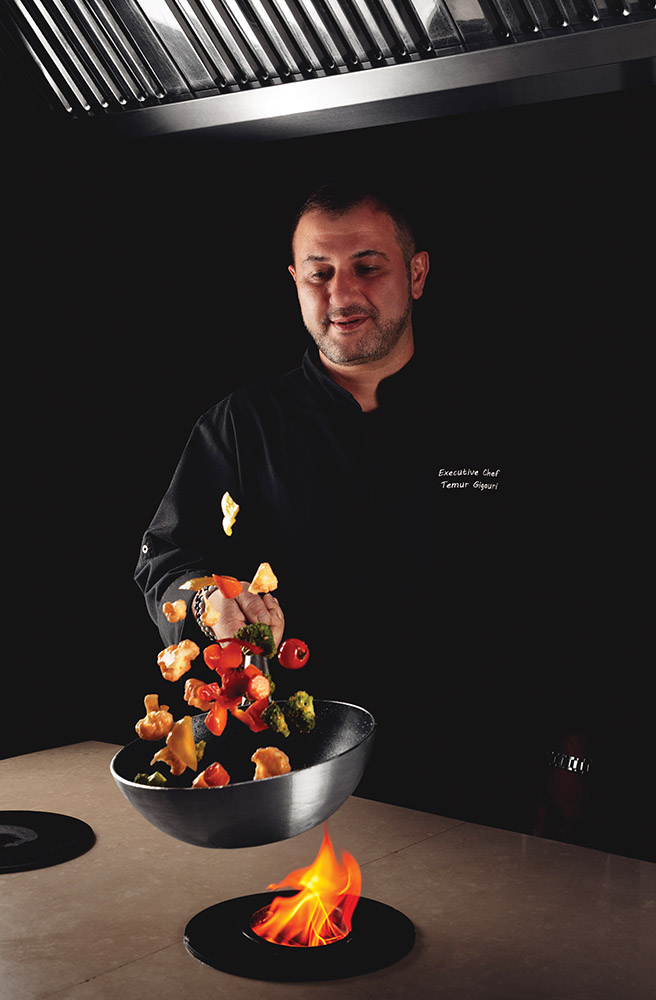
In Lechkhumi, we encounter a unified culinary culture that combines influences from other regions of western Georgia, including the neighbouring and mountainous Racha and Imereti. The local dishes are primarily plant-based and include light meats. Generally, the culture of pkhaleuli (traditional dishes made from leafy greens or vegetables, typically seasoned with walnuts, herbs, and garlic), holds a special place in both western and eastern Georgian cuisine, and Lechkhumi is no exception in this regard.
One of the best appetisers from Lechkhumi is pkhaleuli which we will pair with a classic dry Tsolikouri from Tvishi.
This is a well-balanced wine with vibrant acidity, citrus and tropical fruit aromas, a light yet complex structure, and a long finish. A wine like this definitely calls for an appetiser with fresh, spicy, and zesty flavours, which is exactly what Pkhaleuli offers.
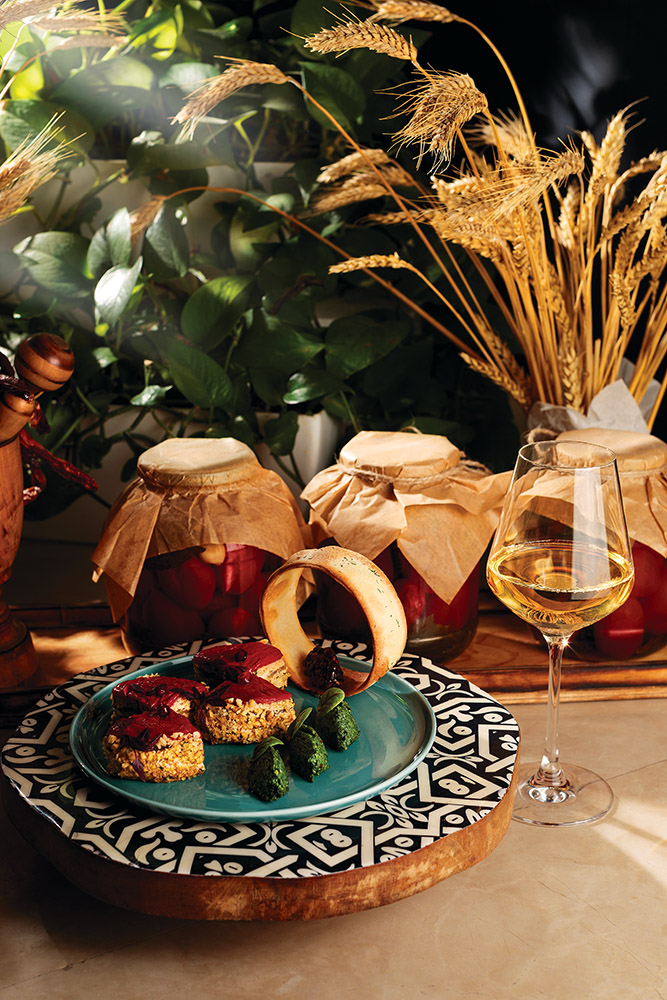
This dish combines eggplant, zucchini, and various peppers to create a delightful blend of spiciness, acidity, and the pleasant tannins from walnuts. Paired with a highly-acidic Tsolikouri, bursting with fruity and citrus aromas, it offers a perfectly balanced and flavourful experience. This combination is ideal for starting dinner, supper or lunch.
A Dish Made from Beans and Okureshi Usakhelouri
Beans and Lobiani (a traditional bread stuffed with mashed beans) are among the most popular and beloved dishes in both Racha and Lechkhumi. Here, you’ll find various ways of preparing and seasoning this legume. In this case, we have bean balls seasoned with various Lechkhumi spices and herbs, followed by beans blended with flakes of Lechkhumi bacon—perfectly balanced, with a creamy texture, velvety and soft, yet rich in the diverse effects of spices and flavours. To add a pleasant acidity and enhance the taste, the dish is accompanied by Jonjoli (pickled bladdernut) and red cabbage dressed in Kakhetian oil, which complements the creamy texture of the beans and provides the pleasant acidity necessary to pair with a high-class wine like the dry Okureshis Usakhelouri. The refined berry aromas of this wine often evolve into earthy, smoky, and spicy notes.
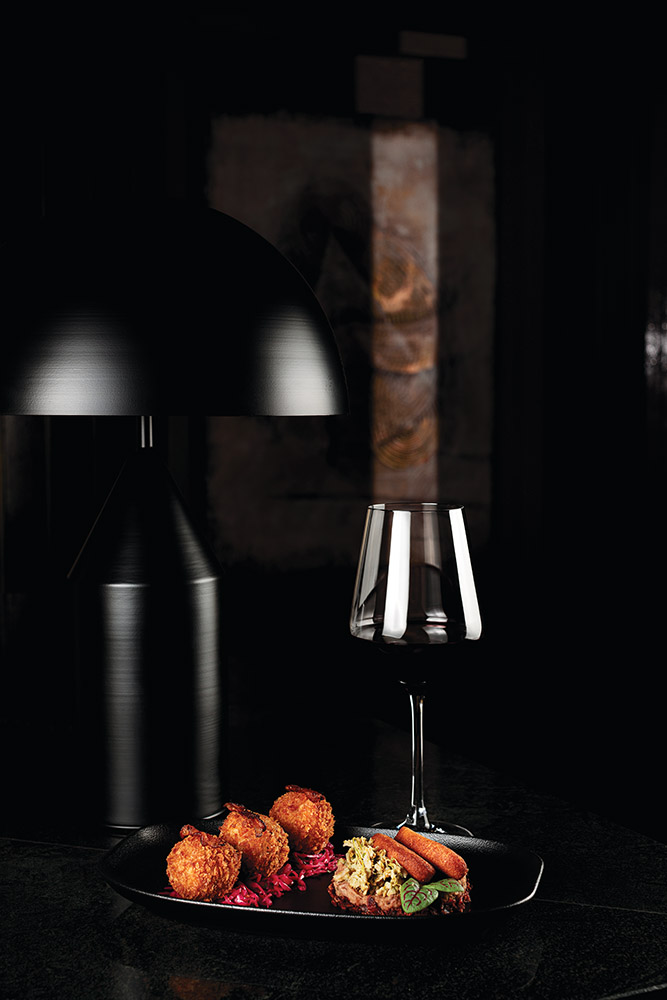
Its pleasant acidity, light to medium body (depending on the terroir), and velvety texture create a remarkable experience during tasting. The wine is so smooth, delicate, and enjoyable that you hardly notice it touching your palate.
This dish—with its delicate, velvety, yet well-structured flavours—shutters all stereotypes about the ‘heaviness’ of bean-based dishes, making it an ideal match for Usakhelouri.
Together, they form an exceptional pairing.
Shkmeruli and Qvibari Tsolikouri
When discussing Lechkhumi qvibari wine, it’s essential to pair it with a dish that delivers a remarkable impact. On this occasion, we’ve chosen one of the region’s renowned dishes—Shkmeruli, presented in an intriguing variation by the brand chef: a chicken roulade seared with Meskhetian Tenili cheese, served in a sauce made from homemade cream and roasted garlic. The Tenili cheese imparts a savoury saltiness to the chicken’s white meat, complemented by the delightful aroma of roasted garlic.
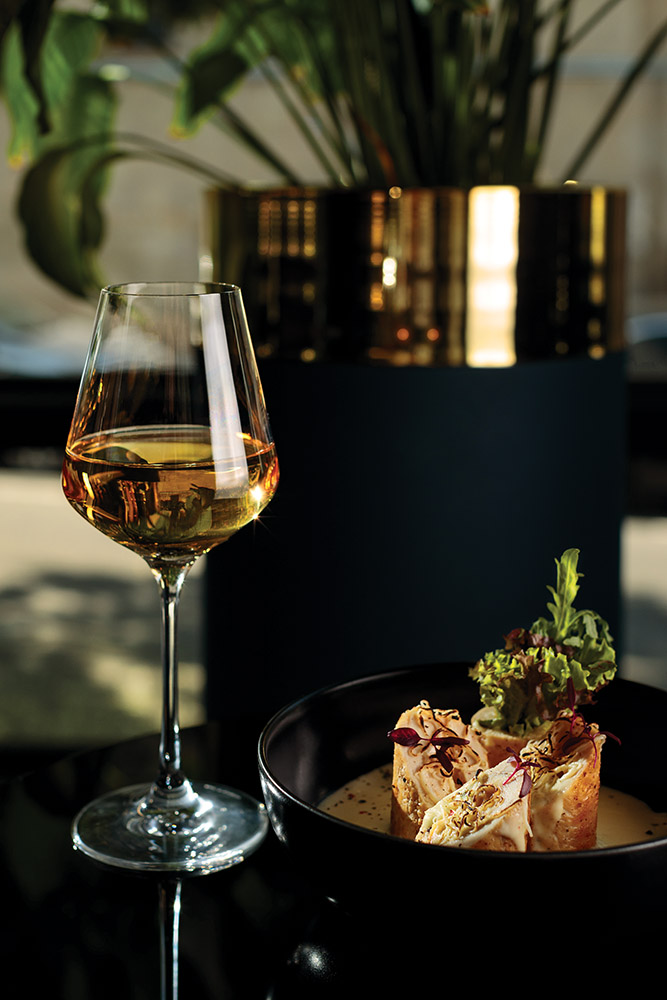
This dish pairs wonderfully with Qvibari Tsolikouri, aged on 30% Chacha (pomace), with a pleasant golden hue, from the village of Alpana in Lechkhumi. The wine features aromas of yellow flowers, subtle citrus zest, green and red peppers, as well as hay and dried leaves, creating a delightful effect. Its acidity and slightly astringent tannins complement Shkmeruli perfectly, while the acidity also cuts through the roasted garlic flavour in the dish. The combination of the wine and dish creates an ideal tertiary flavour— a synthesis of creaminess, spiciness, and, finally, citrus acidity.
ლეჩხუმი – ზღაპრული მხარე ღვინითა და კულინარიით
| თაზო თამაზაშვილი |
საქართველოს მეღვინეობის მხარეებიდან ერთ-ერთი ლეჩხუმია, რომელმაც ბოლო წლებია, განსაკუთრებით მიიქცია ჩემი ყურადღება. ამ რეგიონს პირველად, ექვსი წლის წინ ვესტუმრე. აქაური მცირე მწარმოებლის, დათო ჩაკვეტაძის რთველში ჩასულმა მოვინახულე ვენახები, ბუნება, მათ შორის, ხვამლის მთა. მაშინდელი პირველი შთაბეჭდილება ასეთი იყო: ლეჩხუმი სამოთხის ბაღში ჩადგმულ დიდ ციხე-სიმაგრეს ჰგავს, რომელიც შემოსაზღვრულია დიდი კლდეებით და ამავდროულად, არც სიმწვანე აკლია. რატომ დავიწყე საუბარი ამით?! იმიტომ, რომ ლეჩხუმის ყველაზე დიდი სიმდიდრე სწორედ მისი ადგილმდებარეობაა და რა თქმა უნდა, ხალხი, რომელიც ინარჩუნებს და აგრძელებს იმ ტრადიციას, რაც ამ მხარეში ღვინის წარმოებას უკავშირდება. დიახ, ლეჩხუმს მეღვინეობის დიდი ტრადიციები გააჩნია. აქ გვაქვს კლიმატისა და ნიადაგების საუკეთესო შეხამება, რასაც თან ახლავს ყურძნის საინტერესო ჯიშები.
დღეს, ლეჩხუმი, რაჭასთან ერთად, რაჭა-ლეჩხუმის მეღვინეობის რეგიონად არის მონიშნული, თუმცა ისინი ერთმანეთისგან მაინც განსხვავებულია. ლეჩხუმი გახლავთ სვანეთის მოსაზღვრეც, რომელიც როგორც კულტურით, ისე ტრადიციებით, ყოველთვის განსხვავდებოდა რაჭისაგან. და რადგან სვანეთში ღვინო არ იწარმოებოდა, ამიტომ მეღვინეობის მაღალმთიანი რეგიონებიდან გამოიყო რაჭა-ლეჩხუმი.
ვენახებს ლეჩხუმში შესანიშნავი ადგილმდებარეობა აქვს. მათი უმეტესობა რიონისა და ცხენისწყლის ხეობებშია გაშენებული. მთავარი რეგიონული ცენტრი, რომელიც მეღვინეობის სოფლებს აერთიანებს, ცაგერია. ასევე გამოვყოფდი ალპანას, რომელიც შედის ხვანჭკარის ადგილწარმოშობის დასახელების ზონაში და ამავე დროს, ის ტვიშის ადგილწარმოშობის დასახელების ზონაშიც არის მოაზრებული.
ტვიში დაცული ადგილწარმოშობის დასახელების ღვინოა. ის დარეგისტრირებულია როგორც თეთრი ბუნებრივად ნახევრად ტკბილი ღვინო. სხვა ვარიაცია (მაგალითად, მშრალი ღვინო) მას არ აქვს და არც არის დაშვებული ადგილწარმოშობის კანონით. ტვიშის დასამზადებლად მხოლოდ ცოლიკოურის ჯიშის ყურძენი გამოიყენება.
ცაგერის მუნიციპალიტეტშია სოფელი ოყურეში. ეს არის აბსოლუტურად ფანტასტიკური ადგილი, რომელიც, როგორც ზემოთ აღვნიშნე, კლდებიითა და სიმწვანით გარემოცულ გარემოში ციხე-სიმაგრესავით არის ჩადგმული.
ოყურეშში გვხვდება ულამაზესი ფერდობები. სწორედ ეს ფერდობები და ნიადაგებია ძალიან ხელსაყრელი ვენახებისთვის, რადგან მათ საუკეთესო დრენაჟით უზრუნველჰყოფს.
ოყურეშის უსახელოური კიდევ ერთი დაცული ადგილწარმოშობის დასახელების ღვინო გახლავთ. უსახელოურს მომხმარებელი ჯერ კიდევ ბუნებრივად ნახევრად ტკბილ ღვინოდ იცნობს, რაც საბჭოთა პერიოდს უკავშირდება, თუმცა დღეს, ამ ჯიშისგან მშრალი და ნახევრად მშრალი ღვინის დამზადებაც არის დაშვებული. უსახელოური აღმოსავლეთ ევროპაში ყველაზე ძვირადღირებული ყურძნის ჯიშია, გამომდინარე მისი სიმცირიდან და მაღალი ხარისხიდან, რასაც ლეჩხუმში არსებული ნიადაგურ-კლიმატური პირობები განაპირობებს. ზაფხულის თბილი დღეებისა და ცივი ღამეების მონაცვლეობა ყურძენში არომატების განვითარებას და მათ კომპლექსურობას უწყობს ხელს. ამ ნიშნით, ლეჩხუმი ყურძნის როგორც თეთრი, ისე წითელი ჯიშებით ნამდვილად გამორჩეულია.
ლეჩხუმში ცოლიკოურს ყოველთვის მშრალად აყენებდნენ, მანამდეც, ვიდრე ბუნებრივად ნახევრად ტკბილი ტვიში დაცული ადგილწარმოშობის დასახელების ღვინოდ დარეგისტრირდებოდა. ეს ტრადიცია შენარჩუნებულია დღესაც. ლეჩხუმის ცოლიკოური გამოირჩეოდა და გამოირჩევა ცოცხალი მჟავიანობით, რაც მას საშუალებას აძლევს, ჰქონდეს ბოთლში მრავალწლიანი დაძველების პერსპექტივა. ცოლიკოური თავისუფლად შეგვიძლია შევადაროთ ისეთ საერთაშორისო (და ამავე დროს, ჩემს საყვარელ) ჯიშის – რისლინგს.
ლეჩხუმის პერსპექტივებზე თუ ვისაუბრებთ, უნდა აღვნიშნოთ, რომ აქ საჭიროა, ტერუარების მეტად კვლევა, ვენახების განახლება, ადგილწარმოშობებისა და ღვინის სტილების სწორად მორგება ამ რეგიონზე. აქ უამრავი სოფელია, სადაც შეიძლება სხვადასხვა ტერუარი მოიძებნოს. რა თქმა უნდა, აუცილებელი არ არის, პატარა ლეჩხუმში დაცული ადგილწარმოშობის დასახელების ბევრი ზონა გვქონდეს, მაგრამ ტერუარები სახელწოდებების მიხედვით რომ უნდა იყოს გამოყოფილი, ეს უდავოა. იგივე აღვნიშნე წინა ნომერში გურიაზე. მსგავსი პერსპექტივა აქვს ლეჩხუმსაც, რადგან არის ძალიან პატარა, ამიტომაც აუცილებლად უნდა ჰქონდეს თავისი კონკრეტული ნიშა, რითიც შეფასდება და დაფასდება ეს რეგიონი.
ლეჩხუმში უამრავი ფერდი გვხვდება. ასეთ ლანდშაფტზე ვენახების გაშენება და მათთან მუშაობა რთულია, თუმცა ამ ნიშნით გამორჩეული არაერთი ცნობილი რეგიონი ვიცით მაგალითად, ავსტრიაში, გერმანიაში და სხვა. საქართველოს მეღვინეობის პატარა რეგიონებს ყოველთვის ვადარებ მსოფლიოს ისეთ განვითარებულ რეგიონებს, რომლებიც ერთმანეთს გვანან ყურძნის ჯიშების თავისებურებებით, ლანდშაფტით, ექსპოზიციით. მაგალითად, იტალიაში გვხვდება ასეთივე მაღალმთიანი რეგიონი ტრენტინო ალტო ადიჯე. ხშირად შევხვედრივარ იქაურ მეღვინეებს, რომლებსაც ადგილობრივი უნიკალური ჯიშებისგან ღვინის წარმოების მრავალსაუკუნოვანი ტრადიცია აქვთ. და ასეთივე პატარა რეგიონი – ლეჩხუმი, თავისი უნიკალურობით, შესანიშნავი ჯიშებით – უსახელოურით, ცოლიკოურითა და ორბელური ოჯალეშით. ლეჩხუმში, სოფელი ორბელი თავისუფლად შეიძლება იქცეს ერთ-ერთ ადგილწარმოშობის დასახელებად, ან ტერუარად.
ლეჩხუმს გარს მთები აკრავს, რაც დამცავ ფარს წარმოადგენს და მას გვალვისგან, სეტყვისგან (რაც ბოლო პერიოდში, საქართველოს სხვადასხვა რეგიონში განსაკუთრებით არის გახშირებული) იცავს.
ლეჩხუმში ვხვდებით მცირე მწარმოებლებსა და საოჯახო მარნებს ტრადიციული ყვიბარისა და ჭურის ღვინოებით. ზოგადად, ამ მხარეში უფრო მეტია ტრადიციული სტილის ღვინოები, ვიდრე კლასიკური.
ყვიბარი ლეჩხუმში დამკვიდრებული მცირე ზომის საღვინე ჭურჭელია. ყვიბარისა და ჭურის ტევადობას აქ დორას (საზომი ერთეული) მიხედვით საზღვრავენ. სამდორიანზე პატარა ჭურს ყვიბარს უწოდებენ, უფრო დიდს – ჭურს. სიმაღლეში დაახლოებით 80 სანტიმეტრია. ლეჩხუმური ყვიბარი და იმერული ქოცო ერთი და იგივე შინაარსის მატარებელი სახელწოდებებია. ყვიბარი ძალიან მოსახერხებელი და გამოსადეგი ჭურჭელია ღვინის შესანახად, მასში ოქსიდაცია ნაკლებად შესაძლებელია. ზომით მომცროა, ამიტომ მისი დაზიანების (განსხვავებით ჭურისგან და ქვევრისგან) საშიშროებაც ნაკლებია. ამ სახელწოდებით ეს ჭურჭელი მხოლოდ ლეჩხუმში გვხვდება. საზომი ერთეულის დასახელებაც საქართველოს ყველა რეგიონს სხვადასხვა აქვს, მაგალითად, ლეჩხუმში – დორა, იმერეთში – ფუთი.
რაც შეეხება ადგილწარმოშობის დასახელების ღვინოების პერსპექტივებსა და სტილების გამრავალფეროვნებას, რაც ამ რეგიონში ნამდვილად შესაძლებელია: ლეჩხუმში გვაქვს ტვიში, რომელიც ბუნებრივად ნახევრად ტკბილი ღვინოა. ზოგადად, ტკბილი ღვინოები მისაღებია სამყაროსთვის, მაგრამ არსებობს უფრო დახვეწილი ტექნოლოგიები, თუნდაც გვიანი მოსავალი. აქ Ice Wine-ც თავისუფლად შეიძლება იწარმოოს, რისთვისაც საჭიროა ყურძნის ჯიშები, რომლებიც ზამთარის ყინვებს უძლებს. ვფიქრობ, ამ სტილისთვის უსახელოურიც და ცოლიკოურიც ნამდვილად გამოსადეგია.
ამ მხარეში ღვინის დასაყენებლად იყენებენ (გაშენებული აქვთ) სხვა ჯიშებსაც – წულუკიძის თეთრა, ძელშავი, რაჭული მწვანე. მთავარი თეთრი ყურძნის ჯიში ცოლიკოურია და გამომდინარე ტვიშის ადგილწარმოშობიდან, მასზე მოთხოვნაც დიდია.
რაც შეეხება ოყურეშის უსახელოურს, როგორც აღვნიშნე, საბჭოთა პერიოდში პოპულარული იყო ბუნებრივად ნახევრად ტკბილი უსახელოური, რაც ამ ჯიშს აბსოლუტურად უკარგავდა და უკარგავს იმ ტიპურობას და მნიშვნელოვან შესაძლებლობებს, რაც გააჩნია. უსახელოურისგან წარმოებული ღვინო აუცილებლად უნდა იყოს მშრალი. როდესაც ჩვენ ვსაუბრობთ ქართულ დიდებულ ღვინოზე, ჩვენ ვსაუბრობთ იმ სტილზე, რომელსაც ეწოდება მშრალი ღვინო. და დღეს, ჩემი აზრით, აღარ უნდა გვიწევდეს კამათი მშრალისა და ნახევრად ტკბილი ღვინოების უპირატესობებზე ისეთ შესანიშნავ რეგიონებში, რომელთაგან ერთ-ერთი ლეჩხუმია.
ძალიან მნიშვნელოვანია, ასეთ პატარა რეგიონებში ტურიზმის განვითარება, რათა სხვადასხვა ქვეყნიდან სულ უფრო მეტ ადამიანს მიეცეს შესაძლებლობა, მოინახულოს ეს უმშვენიერესი მხარე, გაიცნოს მისი კულტურა, ტრადიციები, სამზარეულო. აუცილებლად უნდა განვითარდეს ღვინის ტურიზმი, რაც განაპირობებს მეტი დახვეწილი ღვინის წარმოებას. სწორედ ამ მხარეში ტურისტებად უნდა ჩამოდიოდნენ ღვინის მწერლები, სომელიეები, კრიტიკოსები, ღვინის მაგისტრები, რომლებიც აქაურ ღვინოს მისცემენ შესაძლებლობას, არ იყოს დამოკიდებული ერთ რომელიმე სტილზე, ან ერთ რომელიმე ბაზარზე. ეს იქნება საუკეთესო შესაძლებლობა, რათა ძველი თუ ახალი თაობის მეღვინეებმა შეძლონ განვითარება – განავითარონ რეგიონი, გაზარდონ ვენახების ფართობი, აწარმოონ მეტი ხარისხიანი ღვინო.
ლეჩხუმური კერძებისა და ღვინოების შეხამება
ლეჩხუმის თემაზე საავტორო კერძები სასტუმრო Wyndham Grand Tbilisi-ს ბრენდ შეფმა თემო გიგაურმა მოგვიმზადა.
ლეჩხუმში დასავლეთ საქართველოს სხვა კუთხის სამზარეულოების გაერთიანებულ კულტურას ვხვდებით, მათ შორის, მეზობელი მთიანი რაჭის, ასევე იმერეთის. აქაური კერძებიც უმეტესად მცენარეული და მსუბუქი ხორცეულია. ზოგადად, ფხალეულის კულტურა როგორც დასავლეთ, ისე აღმოსავლეთ საქართველოს სამზარეულოში განსაკუთრებულ ადგილს იკავებს. ამ მხრივ გამონაკლისი არც ლეჩხუმია.
ლეჩხუმის ერთ-ერთი საუკეთესო აპეტაიზერი სწორედ ფხალეულია, რომელსაც ტვიშის კლასიკურ მშრალ ცოლიკოურთან შევახამებთ.

ეს არის კარგად დალანსებული ღვინო ცოცხალი მჟავიანობით, ციტრუსოვანი და ტროპიკული ხილის არომატებით, მსუბუქი, კომპლექსური და ხანგრძლივი დაბოლოებით. ასეთ ღვინოს აუცილებლად ესაჭიროება ცოცხალი, სანელებლიანი, ციცნხალი გემოების აპეტაიზერი და ეს სწორედ ფხალეულია.
ბადრიჯნის, ყაბაყისა და სხვადასხვა წიწაკების ერთობლიობა კერძში გვაგრძნობინებს სიცხარესაც, მჟავიანობასაც, ნიგვზის ტანინსაც, რომელიც ძალიან სასიამოვნოა. ეს ყველაფერი მაღალმჟავნიან, ხილისა და ციტრუსოვანი არომატებით გაჯერებულ ცოლიკოურთან კარგ ბალანსსა და გემრიელ გემოს ქმნის. ასეთი წყვილი საუკეთესო დასაწყისია როგორც სადილის, ისე ვახშმისთვის. ამ ცინცხალი გემოებით შეგიძლიათ ისიამოვნოთ ლანჩის დროსაც.
ლობიოსგან მომზადებული კერძი და ოყურეშის უსახელოური
ლობიო და ლობიანი როგორც რაჭაში, ისე ლეჩხუმში ერთ-ერთი პოპულარული და საყვარელი კერძია. აქ ამ მარცვლეულის მომზადებისა და შეკმაზვის სხვადასხვა ვარიაციებს შეხვდებით.

ამ შემთხვევაში მოცემული გვაქვს ლობიოს ბურთულები, შეკმაზული სხვადასხვა ლეჩხუმური სანელებლით და მწვანილებით, რასაც მოჰყვება ლეჩხუმური ლორის ფანტელით შეზავებული ლობიო – იდეალურად დაბალანსებული, კრემისებური სტრუქტურის, ხავერდოვანი, რბილი, ამავდროულად, მდიდარი სანელებლებისა და გემოების სხვადასხვა ეფექტით. სასიამოვნო მჟავიანობისა და დამატებითი გემოს მისანიჭებლად კერძს ახლავს კახური ზეთით შეზავებული ჯონჯოლი და წითელი კომბოსტო, რომლებიც კარგად ეხამება ლობიოს კრემისებრ სტრუქტურას და აძლევს იმ სასიამოვნო მჟავიანობას, რომელიც ისეთი მაღალი კლასის ღვინოსთან შესახამებლად ესაჭიროება, როგორიც ოყურეშის მშრალი უსახელოურია. ამ ღვინის დახვეწილი კენკროვანი არომატები ხშირად გადაიზრდება მიწის, კვამლისა და სანელებლების არომატებში. მისი სასიამოვნო მჟავიანობა, მსუბუქიდან საშუალომდე სხეული (გააჩნია ტერუარს) და ხავერდოვანი სტრუქტურა მირთმევის დროს გვიტოვებს საოცარ არომატებს და ეფექტებს. ღვინო იმდენად რბილი, ნაზი და სასიამოვნოდ მისართმევია, დაგემოვნებისას ვერც ვხვდებით, შეეხო თუ არა ის ჩვენი პირის აპარატს.
ეს კერძი ნაზი, ხავერდოვანი და ამავდროულად, საკმაოდ სტრუქტურული გემოებით, რაც ლობიოსგან მომზადებული კერძების „სიმძიმის“ შესახებ არსებულ ყველა სტერეოტიპს ამსხვრევს, შესანიშნავად ეხამება უსახელოურს და თქვენ წინაშეა შესანიშნავი წყვილი.
შქმერული და ყვიბარის ცოლიკოური
როდესაც ვსაუბრობთ ლეჩხუმური ყვიბარის ღვინოზე, რა თქმა უნდა, აუცილებელია, მასთან ისეთი კერძი შევახამოთ, რომელსაც აქვს ექსტრემალური ეფექტი. ამ შემთხვევაში, არჩევანს ვაკეთებთ ამ კუთხის ერთ-ერთ ცნობილ კერძზე – შქმერულზე, რომელიც ბრენდ-შეფმა საინტერესო ვარიაციით შემოგვთავაზა: ქათმის რულეტი მობრაწული მესხური ტენილი ყველით, რომელიც მოთავსებულია სახლის ნაღებისა და გამომცხვარი ნივრისგან მომზადებულ სოუსში. ტენილი ყველი ქათმის თეთრ ხორცს, რომელსაც გამომცხვარი ნივრის სასიამოვნო არომატები ახლავს, ანიჭებს მარილიანობას.

ამ კერძს ძალიან უხდება 30% ჭაჭაზე დაღვინებული, სასიამოვნო ოქროსფერი შეფერილობის ცოლიკოური, ლეჩხუმის სოფელ ალპანადან, რომელიც გამოირჩევა ყვითელი ყვავილის, ოდნავ ციტრუსის ცედრის, მწვანე და წითელი წიწაკის, ასევე თივისა და გამომშრალი ფოთლების არომატებით, რაც ძალიან კარგ ეფექტს ქმნის. ღვინის მჟავიანობა და ოდნავ მსუსხავი ტანინები შესანიშნავად ეხამება შქმერულს. მისი მჟავიანობა კარგად „ჭრის“ კერძში გამოყენებული გამომცხვარი ნივრის გემოსაც. ღვინისა და კერძის არომატების ერთობლიობა ქმნის იდეალურ მესამეულ გემოს – ნაღების, სანელებლების, ბოლოს კი ციტრუსის მჟავიანობის სინთეზს.
